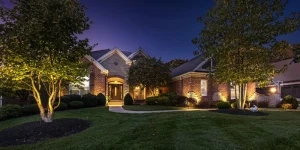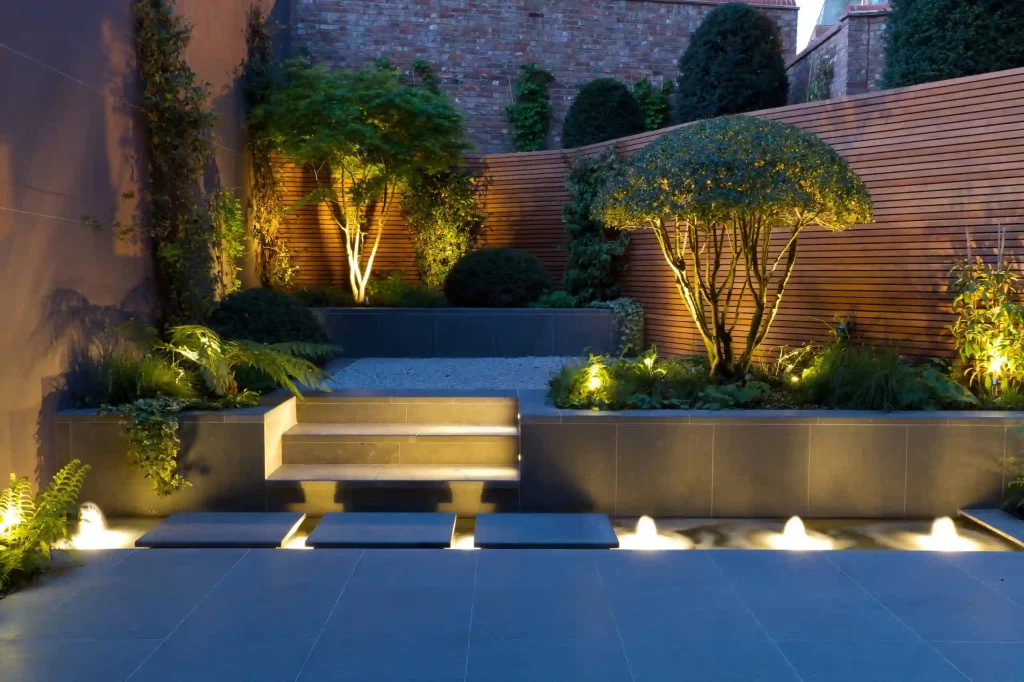Smart technology solutions are redefining uplighting in landscape design. With adjustable LED fixtures and programmable settings, designers can craft versatile lighting scenarios tailored to specific environments. These innovations enhance energy efficiency while prioritizing safety and accessibility. Understanding how to use uplighting in landscape design can elevate the outdoor experience by merging natural beauty with strategic lighting. Yet, the nuances of effective implementation can be complex, raising critical questions about best practices and future developments.
Key Takeaways
- Smart uplighting systems enhance landscape aesthetics through programmable settings, allowing for customizable lighting scenarios that adapt to user preferences.
- Energy-efficient LED fixtures provide sustainable solutions while minimizing electricity costs and environmental impact in modern landscape design.
- Integration of IoT devices enables real-time adjustments to uplighting based on environmental changes, improving functionality and ambiance.
- Uplighting highlights key landscape features, creating dynamic shadows that enhance visual interest and guide safe navigation in outdoor spaces.
- Smart technology in uplighting fosters social interaction and exploration, transforming outdoor areas into inviting, engaging environments for users.
The Importance of Uplighting in Modern Landscape Design
Although landscape design traditionally emphasizes natural elements and spatial arrangement, uplighting has emerged as a crucial component that enhances both aesthetic appeal and functional visibility. By strategically illuminating trees, pathways, and architectural features, uplighting creates a dynamic interplay of light and shadow, transforming outdoor spaces into inviting environments. This technique not only highlights the unique characteristics of landscape elements but also fosters safety and accessibility during nighttime hours. The use of advanced LED technology allows for energy-efficient solutions that can be easily integrated into existing designs. Additionally, uplighting encourages social interaction, as beautifully lit spaces invite gatherings and exploration. As a result, uplighting serves as an essential tool in modern landscape design, fostering a sense of belonging within community spaces.
Key Techniques: How to Use Uplighting in Landscape Design
A variety of techniques exist for effectively using uplighting in landscape design, each tailored to enhance specific features within an outdoor space. One fundamental approach involves positioning lights at the base of trees to create dramatic silhouettes against the night sky, emphasizing their height and form. Another technique is highlighting architectural elements, such as columns or walls, to add depth and texture to outdoor structures. Additionally, uplighting can be applied to pathways, guiding the eye and ensuring safety while creating an inviting ambiance. Strategic placement near water features can also produce mesmerizing reflections, enhancing the overall atmosphere. Ultimately, understanding how to use uplighting in landscape design allows for the creation of cohesive and enchanting outdoor environments that foster a sense of belonging.
Enhancing Outdoor Spaces With Smart Uplighting Solutions
As landscape designers increasingly embrace technology, smart uplighting solutions emerge as a transformative tool for enhancing outdoor spaces. These innovative systems integrate seamlessly with existing designs, allowing for personalized illumination that accentuates architectural features and natural elements. By utilizing adjustable LED fixtures, designers can create dramatic contrasts and subtle highlights, adapting the ambiance to various occasions. Furthermore, programmable settings enable homeowners to customize lighting scenarios, fostering a sense of belonging and connection to their environment. Smart uplighting not only elevates aesthetic appeal but also enhances safety and functionality in outdoor areas. This convergence of artistry and technology empowers landscape designers to craft inviting, dynamic spaces that resonate with the desires of modern homeowners.
Common Mistakes to Avoid When Implementing Uplighting
Many landscape designers encounter pitfalls when implementing uplighting, which can detract from the intended effects of their designs. Recognizing these common mistakes can greatly enhance the aesthetic and functional qualities of outdoor spaces.
- Overusing Brightness: Excessive light can wash out textures and details, creating a harsh environment.
- Neglecting Shadows: Failing to take into account how light interacts with surrounding elements can lead to flat, uninspired appearances.
- Ignoring Placement: Improperly positioned fixtures may fail to highlight focal points or create an inviting ambiance.
Future Trends in Uplighting and Landscape Design Integration
Recognizing common pitfalls in uplighting can pave the way for innovative approaches in landscape design integration. As technology advances, future trends are shifting toward smart uplighting systems that respond to environmental factors and user preferences. The incorporation of IoT devices will allow for real-time adjustments, creating dynamic lighting effects that enhance the landscape’s natural beauty. Additionally, energy-efficient LED solutions are set to dominate, providing sustainable options that align with eco-conscious design principles. The integration of uplighting with smart home systems will foster a seamless user experience, promoting belonging through personalized outdoor spaces. Ultimately, these developments will redefine how to use uplighting in landscape design, bridging the gap between nature and technology in harmonious ways.
Frequently Asked Questions
What Types of Uplighting Fixtures Are Available for Landscapes?
Various uplighting fixtures, such as LED spotlights, floodlights, and wall-mounted lights, enhance landscape design. Each type offers unique illumination capabilities, allowing designers to creatively highlight features while ensuring energy efficiency and aesthetic appeal in outdoor spaces.
How Does Uplighting Affect Plant Growth and Health?
Uplighting enhances plant growth by providing necessary light wavelengths, promoting photosynthesis and vigor. Properly positioned fixtures can mitigate shadow effects, improve aesthetic appeal, and create an inviting atmosphere, fostering a sense of belonging within outdoor spaces.
Can Uplighting Be Used in Small Outdoor Spaces?
Uplighting can be effectively utilized in small outdoor spaces, enhancing visual interest and creating an illusion of depth. Thoughtful placement highlights features, fosters ambiance, and maximizes perceived space, transforming modest areas into inviting retreats.
What Is the Average Cost of Installing Uplighting Systems?
The average cost of installing uplighting systems typically ranges from $2,000 to $5,000, influenced by factors such as the number of lights, installation complexity, and the quality of materials used, ensuring tailored outdoor ambiance.
How Do I Maintain Uplighting Fixtures Throughout the Year?
To maintain uplighting fixtures throughout the year, regular inspections, cleaning of lenses, and checking the electrical connections are essential. Seasonal adjustments guarantee peak performance, enhancing the landscape while prolonging fixture lifespan and aesthetics.
Conclusion
To sum up, smart technology solutions are reshaping uplighting in landscape design, merging aesthetic appeal with innovative functionality. By leveraging adjustable LED fixtures and IoT integration, designers can craft immersive environments that evolve with user needs and environmental changes. As energy efficiency and safety are prioritized, the future of uplighting promises even greater advancements, ensuring that outdoor spaces not only illuminate but also enrich the human experience, fostering a seamless connection between nature and technology.
You May Also Like To Read:
